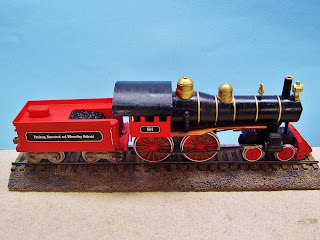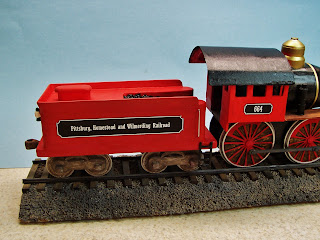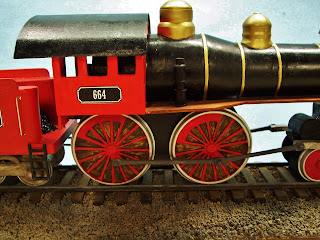First, the history lessons…
I work in the Turtle Creek Valley located just
a few miles east of the City of Pittsburgh, PA in the community of East
Pittsburgh – a really innovative name for a town, huh?:--) The enormous Westinghouse Air Brake (WABCO)
factory built there in 1889. It was and
still is a sprawling collection of buildings of all sorts occupying hundreds of
acres covering nearly all of the flat land in the valley.
The plant employed thousands of workers. “Back in the day,” raw materials, like steel from
the Edgar Thompson plant just a mile or two down the valley in Braddock, came
in one end of the plant and thousands of locomotives, rail cars and all other manner
of railroad related equipment poured out the other. East Pittsburgh is one of several communities
that grew up around the plant so people would have a place to live. Westinghouse moved WABCO up the valley to
the nearby town of Wilmerding many years ago. The original buildings abandoned by Westinghouse are now an
industrial park filled with many newer, smaller companies.
Despite being a place that most people have
never heard of, East Pittsburgh can claim the title of being the birthplace of
commercial radio as we know it today. On November 2, 1920, KDKA went on the
air as the first “regularly scheduled radio station” to broadcast the US
presidential election returns from a shack located on the roof of the K
Building of the Westinghouse factory property. That building is gone now but I can see where it used to stand from my office.
Some time ago, I created a fictitious
railroad that I called “The Pittsburg, Homestead and Wilmerding Railroad”. The
name has popped up in some of my previous works, for example on the station
where the conductor Ollie Bord worked. My reasons for selecting this name and loco
number selection will, for the purposes of this blog, remain my secret but
suffice it to say that anyone who I work with will have no trouble
understanding their significance.
All these towns actually exist. The City of
Pittsburgh lies about 8 miles west of East Pittsburgh. Homestead is an old steel town located west along
the Monongahela River about halfway between Pittsburgh and where the Turtle
Creek valley starts. And Wilmerding is located
just slightly to the east.
You will notice that I intentionally spelled “Pittsburgh”
in the railroad’s name without the “h”.
When Pittsburgh was originally founded in 1758 in honor of
William Pitt the name included the final “h”. Then, in
1890, Pittsburgh was stripped of its “h” by President Benjamin Harrison’s Board
on Geographic Names and lumped in with all of the other cities and towns in the
US already named “Pittsburg”. The proud
citizens of Pittsburgh, PA would have none of this and created such a fuss that the
Board finally relented and restored the 'h' to Pittsburgh in 1911. But since the truncated spelling would have
been in effect during the hay day of my fictitious railroad (late 19th century
to early 20th century), I chose to adopt it.
Now, on to the Locomotive and Tender…
One of my followers is quite an accomplished
Model Railroader and has created some really amazing buildings and rolling
stock for his layout. You can check out
some of the really cool stuff that he has done on his blog. I’m pretty sure that the level of detail,
accuracy and/or overall craftsmanship of my locomotive and tender doesn’t begin to measure
up to his but personally, I’m pretty pleased with the final results.
I mentioned in one of my recent posts that I
wasn’t all that excited about the all black paint job on the original Empire
State Express and that I was planning to go a little “brighter” with my paint
job. In retrospect, I may have kind of overdone
it. The abundance of “tomato” red is a
bit much, but I wanted pizazz and “pizazz” is what I got.
Another irony in my name selection is that the Empire State Express locomotive was equipped with 86" diameter drive wheels and set a land speed record of 112.5 mph in 1883. It is hardly the sort of locomotive that one needs for a little short line like the PH&W would need for its perhaps 10 to 20 miles or right-of-way, but maybe they got a good deal:-)
 |
| Full Side view |
Here is an overall shot. Yes, I even put coal in the tender (bird cage
gravel, glued to a shaped block of wood and painted black).
You can see the “rolled tar paper” effect
that the fine grit sandpaper glued the roof creates.
 |
| Lettering on Tender and Loco |
I’m not much for lettering on models. I took the easy way out and created the
signage in PowerPoint, cut them out and just glued them on.
 |
| Drive Wheels |
The spaces between the spokes of the drive wheels that
are supposed to be "open" ( but can't be without jeopardizing structure strength) show up more in this photo than they do when you see
the actual piece.
I may have to go back
and darken them up some to make them “disappear” a little better.
 Even the nose has a number.
Even the nose has a number.
As my wife and I discussed at lunch today, I think that we need a couple of characters to demonstrate just how big this loco is. So, I may not be quite done after all.
Hope you like what you see.
'Til next time...Keep makin' Chips!